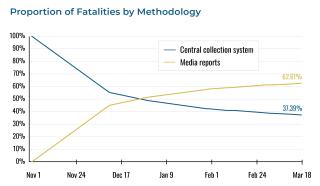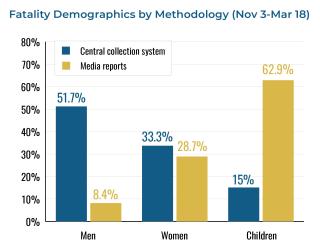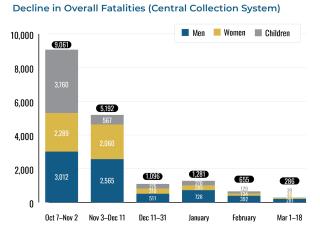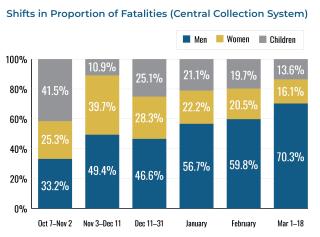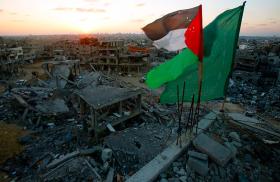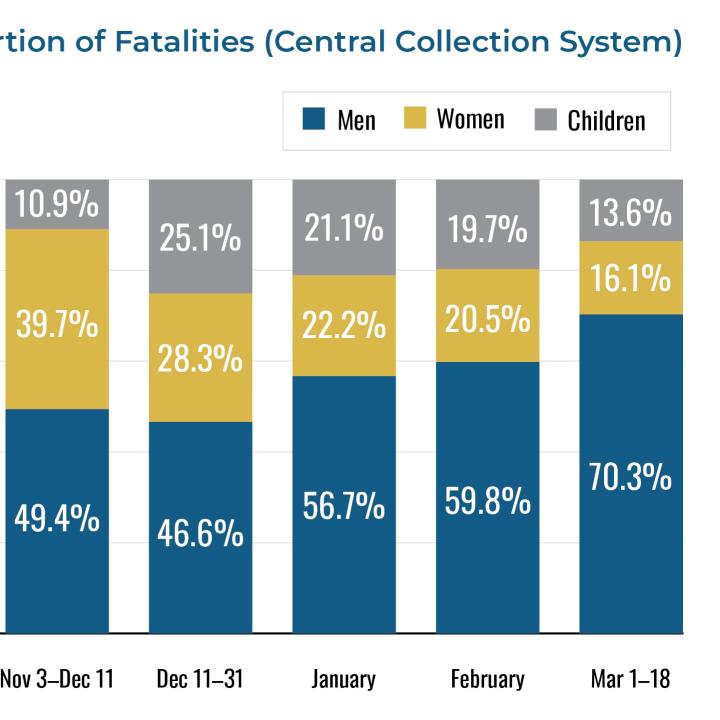
- Policy Analysis
- PolicyWatch 3851
Gaza Fatality Data Has Become Completely Unreliable

Given the discrepancies in official Palestinian counts and their growing reliance on questionable data from media reports, the credibility gaps revealed by a previous Washington Institute study have become yawning chasms.
Heated debates over the Palestinian death toll in the Hamas-Israel war tend to focus on the fact that widely cited fatality numbers make no distinction between combatants and noncombatants. While this is true, it misses a more fundamental problem—the numbers themselves have lost any claim to validity.
In the first month of the war, the Hamas-controlled Ministry of Health (MOH) in Gaza relied on its existing collection system, made up primarily of hospitals and morgues, to certify each death. Starting in early November, however, hospitals in northern Gaza began to shut down or evacuate during the Israeli ground invasion, spurring the MOH to introduce a new, undefined methodology for counting fatalities: media reports. This methodology, which the MOH has rarely acknowledged publicly, accounts for the majority of fatalities reported over the past four months, surpassing the traditional collection system.
A comparison of the two methodologies, using MOH reports and claims published by the Hamas-controlled Government Media Office (GMO), yields wildly different and irreconcilable results, indicating that the media reports methodology is dramatically understating fatalities among adult males, the demographic most likely to be combatants. This undercuts the persistent claim that 72 percent of those killed in Gaza are women and children—a problem that has worsened since it was first noted by a Washington Institute report in January.
The result is that MOH statistics do not appear to offer a reliable guide to the actual Palestinian death toll even by the “foggy” standards of normal wartime reporting. Journalists, analysts, and government officials need to be aware that the actual overall death toll may be significantly higher (or, less likely, lower) than what the MOH has reported; the demographic composition of these fatalities is certainly far different than what the MOH claims.
Building a Database
To assess this problem, the author has assembled a comprehensive collection of publicly available Gaza fatality data that includes:
- Daily updates covering the period October 7 through March 21, obtained from four sources: the Hamas-run MOH in Gaza, the Hamas-run GMO, the Palestinian Authority Ministry of Health in Ramallah, and the UN Office for the Coordination of Humanitarian Affairs (OCHA) (which simply relays Gaza MOH/GMO claims, sometimes inaccurately).
- Compiled data from thirteen Health Sector Emergency Reports published by the Gaza MOH between December 11 and March 18 (these documents can be accessed via the MOH Telegram channel or the Internet Archive).
- Two comprehensive MOH data releases on October 26 and January 7 (the latter covering up to November 2 for all of Gaza and up to January 5 for the south).
The following analysis is based primarily on the Health Sector Emergency Reports and occasional GMO updates.
Download a condensed version of the author’s database (Excel).
(The full database with sources, methodology, and other information will be published on a future date.)
Limitations of Media Reports
The regular methodology used by the MOH (hereafter the “central collection system”) records deaths at hospitals and morgues, along with deaths reported by the Palestinian Red Crescent Society ambulance service and other unspecified sources (for a more detailed explanation of these practices, see the author’s January study). This methodology is well-understood and has been relatively accurate in the past.
Unlike in previous conflicts, however, neither OCHA nor local and international NGOs are currently conducting real-time fatality verification in Gaza or attempting to distinguish between civilians and combatants. Moreover, only a third of Gaza’s hospitals are even partially functional, and many parts of the Strip have serious access problems, curtailing the use of this methodology to count deaths outside of Rafah and Khan Yunis governorates.
On November 10, the MOH announced that it could no longer report deaths from two northern governorates; a month later, officials acknowledged that they were relying on what they called “reliable media sources” to report deaths in those areas. In reality, they had begun using this methodology as early as November 3, according to the MOH dataset released on January 7.
To be sure, it is not uncommon to use news reports when attempting to count deaths in chaotic battlespaces with access issues and damaged institutions. Yet this practice is notoriously difficult and typically looks backward rather than attempting a real-time count. The reliability of any such effort is greatly dependent on its methodological details, but the MOH has refused to elaborate on how it collects this data—a major problem given that media reports have become the dominant input in the Gaza death toll, accounting for more than 14,000 reported fatalities.
Comparing the Methodologies
Despite known problems with the MOH central collection system (outlined in more detail in the author’s January study), it is the more reliable methodology because it involves identity verification and counting of actual bodies. Media reports, by contrast, are much more difficult to verify, regularly lack details necessary to determine the identities or disposition of those killed, and may double-count or miss many fatalities. The divergence between the two methodologies is perhaps best shown by how differently they have reported demographic details about Gaza deaths.
For instance, the MOH Health Sector Emergency Reports provide separate data on men, women, and children when their deaths are recorded through the central collection system, but only a single aggregated figure for deaths gleaned from media reports. When these reports coincide with the GMO’s periodic reports (which provide demographic breakdowns), one can compare how they treat fatalities among different demographic groups.
This comparison reveals sharp differences—most notably, a sixfold decrease in adult male fatalities recorded from media reports and a fourfold increase in child fatalities. (For reference, children make up roughly 50% of Gaza’s population, and men and women make up a quarter each.) Some of these differences may be explained by the fact that media reports are unlikely to capture combatant deaths accurately due to access issues and fear of retribution for exposing Hamas losses. In most cases, however, the numbers are too far apart to be reconcilable, or too divorced from the realities on the ground to be credible.
For example, according to the media reports methodology, only 1,192 men had been killed in northern and central Gaza as of March 18, despite four and a half months of heavy ground fighting (see the author’s condensed database). Five days later, that number inexplicably decreased to 1,170—a feat that would have required 22 men to somehow come back to life by March 23 in order to reconcile the central collection system data with the overall claim. In contrast, Israeli authorities estimate that 13,000 militants have been killed—a figure that may incorporate many combatant deaths not recorded by either MOH methodology.
Without clarification from the MOH, such findings suggest significant omission or manipulation aimed at understating the number of men killed and overstating the number of children killed. One possibility is that fatalities among militants—most of whom are men—are more likely to go unreported because they occur in tunnels or on battlefields, where most reporters are either unable to access bodies or unwilling to risk Hamas retribution or the dangers of combat zones. Another possibility is active manipulation—that is, using the media reports methodology as a smokescreen for altering the data in support of the claim that 72% of those killed are women and children.
Meanwhile, data from the central collection system indicates a sharp decrease in overall deaths since November and a sustained increase in the proportion of men killed.
In addition to the MOH’s growing reliance on the media reports methodology, these trends may reflect various factors on the ground, such as Israel’s shift from a primarily air-based campaign to ground fighting, the mass evacuation of civilians from the north to Rafah governorate, and the decreasing intensity of fighting in areas where the central collection system is still functioning. Such factors would be expected to reduce overall civilian casualties and therefore increase the proportion of adult men killed, since that is the demographic most likely to serve as combatants.
Caveats and Recommendations
This analysis is solely intended to compare various Hamas fatality claims against each other and raise questions about the resultant discrepancies. It makes no claims about the true death toll in Gaza or the civilian-combatant ratio, nor is it meant to distract from the very real and widespread loss of life in Gaza and the severe humanitarian crisis that its population continues to suffer.
Regarding the overrepresentation of men in the fatality statistics, this point is not intended to imply that all Gazan men are militants. Rather, adult men are the most likely to be militants across any group (though Hamas is known to use children in combat and support roles). Their overrepresentation has also been used to help estimate militant deaths in the past.
Caveats aside, the above findings should prompt analysts, media outlets, and government officials to bear the following points in mind when assessing Gaza fatality statistics:
- The discrepancies between the methodologies for counting fatalities warrant much more intense scrutiny and should be paired with appropriate caveats if cited. Whether through passive omission, active manipulation, or both, the Gaza Health Ministry’s media reports methodology significantly understates the number of men killed and may overstate the number of children killed.
- The repeated claim that 72% of the dead are women and children is very likely incorrect. Data from the central collection system indicates that 58% of those killed since the start of the war are women and children; this figure drops to 48% for those killed since November 3. For the 72% claim to be accurate, women and children would have to make up about 90% of deaths recorded from media reports. This proportion is implausible—men comprise a quarter of the population, and these fatalities have largely occurred in areas with fewer civilians and more combatants, most of whom are adult men.
- Data from both methodologies suggests that the war has decreased in intensity. Fatalities have declined from an average of 348 per day in the first weeks of the war to around 85 per day in March.
- The existing data is too limited to allow for definitive conclusions about the true death toll or the civilian-combatant ratio. A high proportion of reported deaths come from an unknown methodology that may be misrepresenting the data, while enormous uncertainty persists regarding how many combatant fatalities go uncounted in tunnels and other battlespaces. The exact proportions of men, women, and children killed are even more unclear. The available data does not allow for reliable estimates about the ratio of civilians to combatants killed either, whether independently or by comparison with Israeli estimates.
Gabriel Epstein is a research assistant in The Washington Institute’s Koret Project on Arab-Israel Relations.
